
Cardiac glycosides are a class of organic compounds that increase the output force of the heart and decrease its rate of contractions by inhibiting the cellular sodium-potassium ATPase pump. Their beneficial medical uses are as treatments for congestive heart failure and cardiac arrhythmias; however, their relative toxicity prevents them from being widely used. Most commonly found as secondary metabolites in several plants such as foxglove plants, these compounds nevertheless have a diverse range of biochemical effects regarding cardiac cell function and have also been suggested for use in cancer treatment.

Robinia pseudoacacia, commonly known in its native territory as black locust, is a medium-sized hardwood deciduous tree, belonging to the tribe Robinieae of the legume family Fabaceae. It is native to a few small areas of the United States, but it has been widely planted and naturalized elsewhere in temperate North America, Europe, Southern Africa and Asia and is considered an invasive species in some areas, such as the temperate east coast of Australia where the cultivar 'Frisia'(Golden Robinia) was widely planted as a street tree before being classed as a weed. Another common name is false acacia, a literal translation of the specific name.

Apocynaceae is a family of flowering plants that includes trees, shrubs, herbs, stem succulents, and vines, commonly known as the dogbane family, because some taxa were used as dog poison. Members of the family are native to the European, Asian, African, Australian, and American tropics or subtropics, with some temperate members. The former family Asclepiadaceae is considered a subfamily of Apocynaceae and contains 348 genera. A list of Apocynaceae genera may be found here.

Ouabain or also known as g-strophanthin, is a plant derived toxic substance that was traditionally used as an arrow poison in eastern Africa for both hunting and warfare. Ouabain is a cardiac glycoside and in lower doses, can be used medically to treat hypotension and some arrhythmias. It acts by inhibiting the Na/K-ATPase, also known as the sodium–potassium ion pump. However, adaptations to the alpha-subunit of the Na+/K+-ATPase via amino acid substitutions, have been observed in certain species, namely some herbivore- insect species, that have resulted in toxin resistance.

Strychnos nux-vomica, the strychnine tree, also known as nux vomica, poison fruit, semen strychnos, and quaker buttons, is a deciduous tree native to India and to southeast Asia. It is a medium-sized tree in the family Loganiaceae that grows in open habitats. Its leaves are ovate and 5–9 centimetres (2–3.5 in) in size. It is known for being the natural source of the extremely poisonous compound strychnine.

Nerium oleander, most commonly known as oleander or nerium, is a shrub or small tree cultivated worldwide in temperate and subtropical areas as an ornamental and landscaping plant. It is the only species currently classified in the genus Nerium, belonging to subfamily Apocynoideae of the dogbane family Apocynaceae. It is so widely cultivated that no precise region of origin has been identified, though it is usually associated with the Mediterranean Basin.
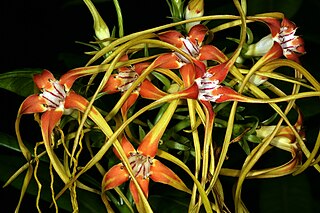
Strophanthus is a genus of flowering plants in the family Apocynaceae, first described as a genus in 1802. It is native primarily to tropical Africa, extending to South Africa, with a few species in Asia from southern India to New Guinea and southern China. The genus name is a compound of the Greek words στροφος (strophos) "twisted" and ανθοσ (anthos) "flower", in reference to the corolla lobes which, in some species - notably S. petersianus - resemble long twisted ribbons or threads and can reach a length of 30–35 cm. This trait, in addition to colouring involving combinations of bright pinks, purples and oranges, combine to make the flowers among the most ornamental in the plant kingdom.
Arrow poisons are used to poison arrow heads or darts for the purposes of hunting and warfare. They have been used by indigenous peoples worldwide and are still in use in areas of South America, Africa and Asia. Notable examples are the poisons secreted from the skin of the poison dart frog, and curare, a general term for a range of plant-derived arrow poisons used by the indigenous peoples of South America.

Actaea rubra, the red baneberry or chinaberry, is a poisonous herbaceous flowering plant in the family Ranunculaceae, native to North America.

Calotropis gigantea, the crown flower, is a species of Calotropis native to Cambodia, Vietnam, Bangladesh, Indonesia, Malaysia, Thailand, Sri Lanka, India, China, Pakistan, and Nepal.

k-Strophanthidin is a cardenolide found in species of the genus Strophanthus. It is the aglycone of k-strophanthin, an analogue of ouabain. k-strophanthin is found in the ripe seeds of Strophanthus kombé and in the lily Convallaria.
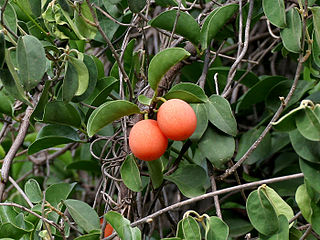
Ximenia americana, commonly known as tallow wood, hog plum, yellow plum, sea lemon, or pi'ut (Chamorro), is bush-forming shrub/small tree; a species from the Ximenia genus in the Olacaceae family. It is mainly found in the tropics, ranging from Africa, India and southeast Asia, to Australia, New Zealand, Pacific Islands, West Indies, Central, North and South America. It is especially common in Africa and South America. It is not domesticated so it is only found occurring in the wild.

Rauvolfia vomitoria, the poison devil's-pepper, is a plant species in the genus Rauvolfia. It is native from Senegal east to Sudan and Tanzania, south to Angola; and naturalized in China, Bangladesh, different ranges of Himalayan and Puerto Rico. The plant contains a number of compounds of interest to the pharmaceutical industry and is widely used in traditional medicine.
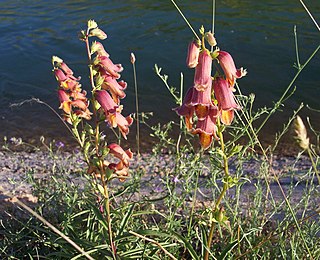
Digitalis obscura, commonly called willow-leaved foxglove or dusty foxglove or spanish rusty foxglove, is a flowering plant native to regions in Spain and Morocco. It is also grown as an ornamental flower. This foxglove is a woody perennial plant belonging to the family Plantaginaceae. Along with the other foxgloves it used to be placed in the figwort family, Scrophulariaceae; however, recent genetic research has moved the genus Digitalis to a larger family. It is similar to many of the foxglove species in its high toxicity and medicinal use as a source for the heart-regulating drug digoxin. Its strikingly distinctive amber- to copper-coloured flowers give the species its name and help distinguish it from other members of the genus.

Strophanthus hispidus, the hispid strophanthus, is a liana or shrub that can grow up to 5 metres (16 ft) tall. Its flowers feature a yellow corolla and yellow corona lobes spotted with red, purple or brown. The seeds, like those of several other Strophanthus species, contain potent cardiac glycosides absorbable through wounds - hence its use in African arrow poisons and later in modern medicine as a digitalis-like heart stimulant. Strophanthus hispidus is native from west tropical Africa east to Tanzania and south to Angola. It is naturalized in China.

Strophanthus preussii, the Preuss' strophanthus, is a plant in the dogbane family Apocynaceae.

Strophanthus sarmentosus grows as either a deciduous shrub or as a liana up to 40 metres (130 ft) long, with a stem diameter up to 15 centimetres (6 in). Its fragrant flowers feature a white to purple corolla, red or purple-streaked on the inside. Strophanthus sarmentosus is native from west and central tropical Africa to Uganda and Angola. Vernacular names for the plant include spider tresses and poison arrow vine. Its habitat is forested areas from sea level to 1,400 metres (4,600 ft) altitude.
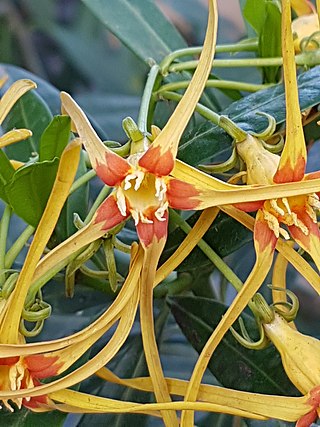
Strophanthus speciosus, commonly known as the forest poison rope, is a tree, shrub or woody climber which is native to southern Africa.

Strophanthus eminii is a species of flowering plant in the Apocynaceae family. It is referred to by the common name Emin's strophanthus, and grows as a liana up to 10 metres (33 ft) long or as a shrub or small tree up to 7 metres (23 ft) tall, with a stem diameter up to 6 centimetres (2.4 in). Its fragrant flowers feature a pink with white turning red corolla tube, white turning yellow with red spots and streaks inside. Vernacular names for the plant include "spider tresses" and "poison arrow vine". Its habitat is deciduous woodland or rocky bushland, from 600 metres (2,000 ft) to 1,650 metres (5,400 ft) altitude. Strophanthus eminii is used in local medicinal treatments for snakebites, skin diseases and wounds and also as an anthelmintic. The plant has been used as arrow poison. It is native to Democratic Republic of Congo, Tanzania and Zambia.
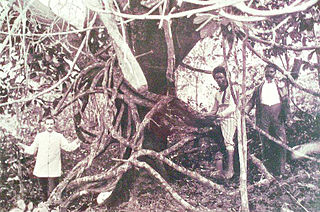
Landolphia owariensis is a species of liana from the family Apocynaceae found in tropical Africa. Latex can be extracted from this plant for the manufacture of natural rubber. Other names for this vine are eta, the white rubber vine and the Congo rubber plant. Congo rubber was a commercial rubber exported from the Congo Free State starting in 1890, most notable for its forced harvesting under conditions of great human suffering, in the Congo Free State, detailed in the 1904 Casement Report. From 1885 to 1908, millions died as a result of murder, deprivation, and disease, with population falling by millions in this period; some writers estimate this loss to be as high as 10 million people.


















